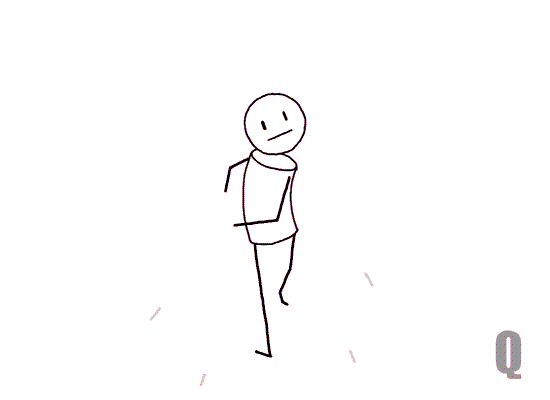Twelve Principles; Fred's Fourteen; Twelve Additional; Nine Economical; Five Emotional
There are 12 principles in animation. These 12 principles
were developed by the men of Walt Disney dating back to the 1930’s. The
principles still apply to animation today and are the base of ever creator’s
animations.
The first principle in animation is squash and stretch. Squash and
stretch give the illusion of weight and volume to the character. Squash and
stretch are apparent in the face of animations as it gives them more character.
The second principle is anticipation. Anticipation prepares
the audience for the action that the character is about to perform. For
example, when a character is preparing to jump, they must bend down first to
gain momentum and then spring upwards to jump in order for the action to look
accurate.
The third principle is staging. This is a pose or action
that gives the audience an idea of the attitude or reaction of the character as
it relates to the story. Staging can depend on the camera angles that give the
audience an idea of the current mood.
The fourth principle is straight ahead and pose to pose.
This principle begins with the first scene and draws to the very en of a scene.
This seems very chaotic and may lose actual accuracy of the animation’s proportion;
however it makes for a very action packed scene. Pose to pose is much more tedious
and planned out. These scenes are done at intervals with very carefully drawn
movements of the character to ensure that they flow as smoothly as possible.
The fifth principle is follow through and overlapping
action. Follow through is when separate parts
of the body continue moving, even after the character has stopped. A great
example of this is a long haired character running and suddenly coming to a
complete stop. Even though the characters body has stopped, his/ her hair
continues to move in the direction that the body was going.
The sixth principle is slow-in-slow-out. Running is another
great example of this principle. This means that a character slow gains the
maximum speed they will reach and will also slow out of the maximum speed back
into the minimum speed or completely stopped.
The seventh principle is arcs. Nearly all actions will
involve in arc somewhere within the movement of the character or thing. Arcs
allow animation more natural action and to appear more believable.
The eighth principle is secondary action. This gives the
scene more life and can help to support the main action. A person walking can simultaneously
swing his/ her arms or keep them in his/her pockets. He/ she can speak or
white, or can express emotion through facial expressions.
The ninth principle is timing, which is a very crucial part
in the development of your animation. The most important thing to remember is
the point A to point B being perfect doesn’t mean that the whole thing will be
perfect. Timing is frame rate x seconds = frames.
The tenth principle is exaggeration. Exaggeration does not
necessarily mean that the animation will be extreme action all the time. This
is more related to facial expressions, body position, features, and attitudes.
The eleventh principle is solid drawing. Solid drawing
consists of using pencil sketches and drawings for the animation of your
characters. Your drawing should mimic life using expressions, color, and
movement.
The twelfth and final principle is appeal. Appeal consists
of an enticing personality to capture your audience’s interest. By giving life
to your animation through expressions, voice, wardrobe, and more...the audience
will relate to your character on a more personal level.
Fred Moore was an animator for Walt Disney, and was known as
one of the great “natural” Disney animators in the 1930’s. Some of Moore’s most
brilliant creations included the seven dwarfs in Disney’s Snow White and the
Seven Dwarfs. Before his passing at the early age of 42, he created:
Fred’s 14 Points of Animation.
1 1. Appeal in drawing
This point is defined in the twelfth
principle above. The audience should feel about certain interest to the
character and even feelings that make the audience worry and care for what
happens to our character. It is about
giving your character a personality that the audience will fall in love with.
2.
2. Staging
Staging is another point explained in the
above principles. Staging gains importance from a particular scene. By staging,
we are giving the audience a view point that set a certain tone for the action
that is going to happen next
3.
3. Most interesting way?
This is an important point because we want
our animations and storylines to attract to everyone of all ages. Pixar and
Disney have done a fantastic job about making their storylines and creations appealing to everybody.
4.
4. Is it the most entertaining way?
This point goes along with the description
above. You want to interest and entertain everybody to gain more likability to
your characters. The bigger the audience, the better.
5. 5. Are you in character?
This point is directly for animators
themselves. In order to create a believable animation, you must believe in it
as well. Getting yourself into the character mentally is something that will
only benefit you as your animation begins to come to life.
6.
6. Are you advancing the character?
Ensuring that you give your character room
to grow is vital for the success of your story. By allowing your audience to
see how your character grows either physically or mentally, you are passing on the
positivity and important of growing as a person.
7.
7. Is it the simplest statement of the idea of the
scene?
It’s important to remember that keeping your
work simple isn’t always boring. By ensuring simple ideas and messages in your
scene, everyone is able to understand that message you are spreading in that
given scene.
8.
8. Is the story point clear?
Make sense of your ideas before you begin!
I cannot stress the importance of have a clear vision and idea of the story you
are trying to tell. Too often people begin a story and have a thousand new
ideas coming into action during the middle of the storyline. Make sense of your ideas before putting them
on paper. This way, your audience is able to follow along perfectly with no
confusion.
9.
9. Are the secondary actions working with the main
action?
This point is all about techniques that
make your character look as realistic as possible. Secondary action, as explain
above, is one that enhances the realism of your character. If your character
turns their head, their hair should move along in that direction as well.
1
10. Is the presentation best for the medium?
Remember, people will be viewing this
animation in all different ways. Ensure that you have the best quality
creations so that they will look amazing no matter how people are watching.
1 11. Does it have 2 dimensional clarity?
Look at any of the recent movies in the
2000’s that Disney and Pixar have created. All though we are watching 2D movies,
the characters appear very life-like because of quality attention put towards
the creation of the characters.
1
12. Does it have 3 dimensional solidarity?
If these characters will be viewed in 3D,
they should be created so well that your audience doe not view false or weak edges,
noisy pixels, or poor filters. Your characters should still stand out in 3D
format.
1
13. Does it have 4 dimensional drawing?
When initially planning your character, and
drawing them step by step, they should already be created with dimension.
1
14. Are you trying to do something that shouldn’t be
attempted?
Playing with expressions, movements, and angles
is acceptable in practice, but should not be attempted when developing scenes
for your characters. You want your audience to feel that they are viewing a
well put together creation rather than an amateur animation.
There are 12 additional points to animation that all
creators and lovers of animation should keep in mind.
1.
Inner feelings and emotions
Relate your animation to your audience. Reveal their thoughts and show
expressions in order for people to connect with them.
2.
Acting with clear and definite action
What are you trying to portray in this scene? What message are you giving
to the audience? Whatever it may be, ensure that it is clear and focused to
make it as understandable as possible.
3.
Character and Personality
Again, give your animation life. Make them do things that people can
relate to or give them feelings that your audience has felt before. This will
connect animation and people together.
4.
Thought Process Through Expression Changes
Imagine yourself changing your expression in reaction to something.
Knowing exactly how your expressions will change is something that will benefit
the way your change the expressions of your characters.
5.
Ability to Analyze
It is important as an animator, to have the ability to analyze your own
work. Know what is good and what needs to be fixed in order to make your
animations successful.
6.
Clear Staging
As previously stated, know exactly what you want your audience to see and
know about that scene at that given time. Clear staging will ensure that your storyline
flows together.
7.
Good Composition
Every scene should be visually interesting to your viewer. Keeping the
scene neat with varieties of things or characters to at will be more appealing
to your audience.
8.
Timing
Again, timing is a key part in every animation. Frames per second will
show you just how much time you have to explain the scene in your storyline.
9.
Solidity in drawing
The skill of drawing is a plus when developing animation. You can create
your character based off of the accurate drawing you’ve developed.
10.
Power in drawing
Your power in drawing is your ability to attract people to your story. Make
your drawings detailed and interesting so that people want to see more.
11.
Strength in Movement
Draw in your crowd by showing the movement of your characters. This will
add visual interest.
12.
Imagination
It’s difficult to think the way we once did as children. Then, anything
was possible and there were no boundaries at all. Channel that inner creativity
and develop something amazing!
Nine Economical Ways that Animation Can Build Emotions in the
Imaginations of the Audience:
1.
Rear View
Rear view in a scene builds a personal and vulnerable mood for a scene.
When a characters back is to the audience, it feels as though you are watching
a personal scene from the distance. Rear view should be used in animation, but
in the correct way.
2.
Shadows
Shadows give a scene suspense that draws the audience
to what is happening in the next scene.
3.
Shadows over the character
Shadows over your character will add drama and
excitement that cause anticipation for action.
4.
Overlays
Overlays are used by covering parts of the character
that often focus the attention to one part of the character.
5.
Dramatic layout
A dramatic layout makes a sense visually interesting
but is also exciting for the viewer to follow the character along in their
interesting scenery.
6.
Pictorial Shot
A pictorial shot is a picture that somewhat blends as
or into the background. This does not involve animation therefore makes the
scene easier to create.
7.
Effects animation
Any effects that you add to your animation will change
or give a set mood or feeling to the scene.
8.
Held drawing with camera moves
Creating a scene with a slow moving camera to a
stopped position will add anticipation and importance to that shot. It gives a
vital feeling to that scene that the audience simply should not miss.
9.
Off stage sounds
Off stages sounds take a lot of the work out of
creating in different scenes for animators. This makes the audience have to
listen in to understand what is happening in that scene which the character may
be inside a building, behind a wall, or under and cover.
There are five additional points to remember about emotion:
1. Ensure that the
character's emotional state is defined
The character should be easy to read
by the audience so that the story is better understood. Every emotion should be
readable and clearly understood so that the scene makes sense to
everyone.
2. The thought process
reveals feeling. Sometimes it can be shown with a single held drawing or a
simple move. Other times there should be gestures, body moves, or full action.
Determine which is best.
Uses the best movements at the best
times in order to make your animations as believable as possible.
3. Be alert to use of cutting and
camera in helping to accentuate the emotion
Cutting means that the scene is
being cropped in order to focus in on the thing or character. This will give
the audience a better understanding of what you are trying to tell them.
4. Ask yourself constantly: What am
I trying to say here? What do I really want to show? How do I want the audience
to react?
Keeping your thoughts and ideas
together will help you better tell your story to the audience. By doing this,
you will not be confused of your message and your audience will understand
exactly what your message is saying.
5. Use the element of time
wisely: to establish the emotion of the character, to convey it to the viewers,
to let them savor the situation. Don’t be ponderous, but don’t take it away
from them just as they start to enjoy it.
Know the right time to give your
audience what they've been waiting to know or see. Present the climax of your
story in a satisfying way, and don't steal the excitement away too early before
your audience can appreciate the work you have put in to developing such an
entertaining storyline.






































